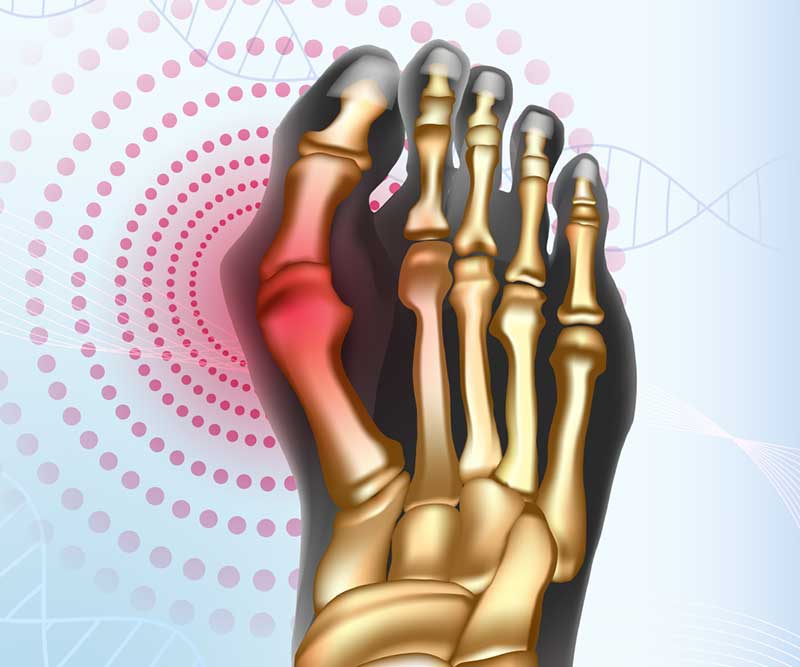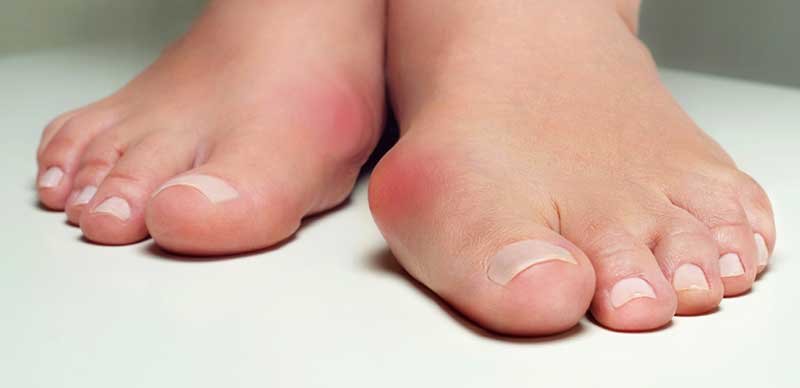
Discover how we can help you find relief from bunions.
A bunion (hallux valgus) is a bump that typically appears on the side of the big toe. The characteristic bump of bunions is created when the big toe leans towards the adjacent toe (second toe) instead of pointing forward. Smaller bunions called bunionettes sometimes develop on the little toe. A bunion is a progressive foot condition that usually develops gradually.
- Some people will have pain from bunions while other individuals will have no symptoms at all.
- Most patients respond well to non-surgical treatments, or reach a point where any experienced discomfort can be managed.
What Causes Bunions?
Bunions form when tissue or bone forces the joint located at the bottom of the big toe to move of place. This structural abnormality is sometimes caused by several years of added or abnormal pressure on the big toe joint. The condition is widely to be genetic in nature. What this is means is that bunions sometimes develop due to inherited irregularities with the bone structure of the big toe. Therefore, it’s possible for bunions to run in families.
Bunions may also develop due to other medical conditions that affect the bones and joints of the foot. Underlying neuromuscular diseases or progressive, inflammatory conditions such as gout or rheumatoid arthritis may also affect tissues and bones in the big toe. Some people will get a bunion because of poor foot function caused by a partially or completely collapsed arch.
Statistically, women and older individuals are more likely to develop bunions. People who wear ill-fitting shoes won’t necessarily develop bunions. However, such habits may contribute to the condition in individuals already genetically predisposed to developing bunions. Children born with flat feet are also at an increased risk of having issues with bunions.


Common Symptoms
Some individuals will have no symptoms at all with bunions. Other people may notice increased foot pain when standing or walking for long periods of time. The most noticeable sign of a bunion is the appearance of a visible bump on the big toe. The deformity may also result in persistent foot pain, a decreased ability to flex or move the big toe, and discomfort that comes and goes depending on what specific foot movements are being made. People with bunions may also notice:
- Calluses on the second toe
- Thick skin on the underside of the big toe
- Inflammation and redness
- Numbness in the big toe
How Are Bunions Diagnosed?
Since most signs of bunions are outwardly visible, diagnosis usually involves an examination of the affected toe. Patients may be asked to move their big toe so any issues with movement and flexibility can be detected. Patients are sometimes asked to walk to determine if the deformity is causing problems with gait.
An X-ray might be ordered if it’s believed that an injury or an underlying issue with the bones and soft tissues of the foot may be contributing to symptoms. A blood test may be done to rule out arthritis as a contributing factor.
Non-Surgical Treatment Options
In addition to prescription anti-inflammatory drugs, acetaminophen, ibuprofen, and naproxen are the common over-the-counter medications often recommended for patients with bunions. Treatment may also involve applying ice to the affected area to ease swelling and irritation, or padding or taping the affected toe into a normal position to ease related pressure. Other non-surgical treatment possibilities include:
- Activity modifications
- Injection therapy
- Over-the-counter or custom orthotics

Surgical Treatments
If non-surgical remedies and treatments aren’t helping, surgery may be the better option for relief from foot pain. While there are over a hundred surgeries for bunions, the procedure typically performed is called a bunionectomy, which involves removing swollen tissue and correcting the position of the big toe. For children with bunions not responding well to conservative treatments, surgery is usually delayed until skeletal maturity is reached, which is usually around 15-17 years of age.
Wearing shoes that are supportive and comfortable is one of the most effective ways to prevent bunions from developing, especially if you have structural issues with your feet that increase your risk for this deformity. Opt for shoes that provide sufficient room around your big toe. Ideally, you should have room to wiggle your toe without resistance from your shoe’s material. If you have a problem with over-pronation, which can make you more susceptible to bunions, arch supports or custom inserts may minimize inward foot rolling.